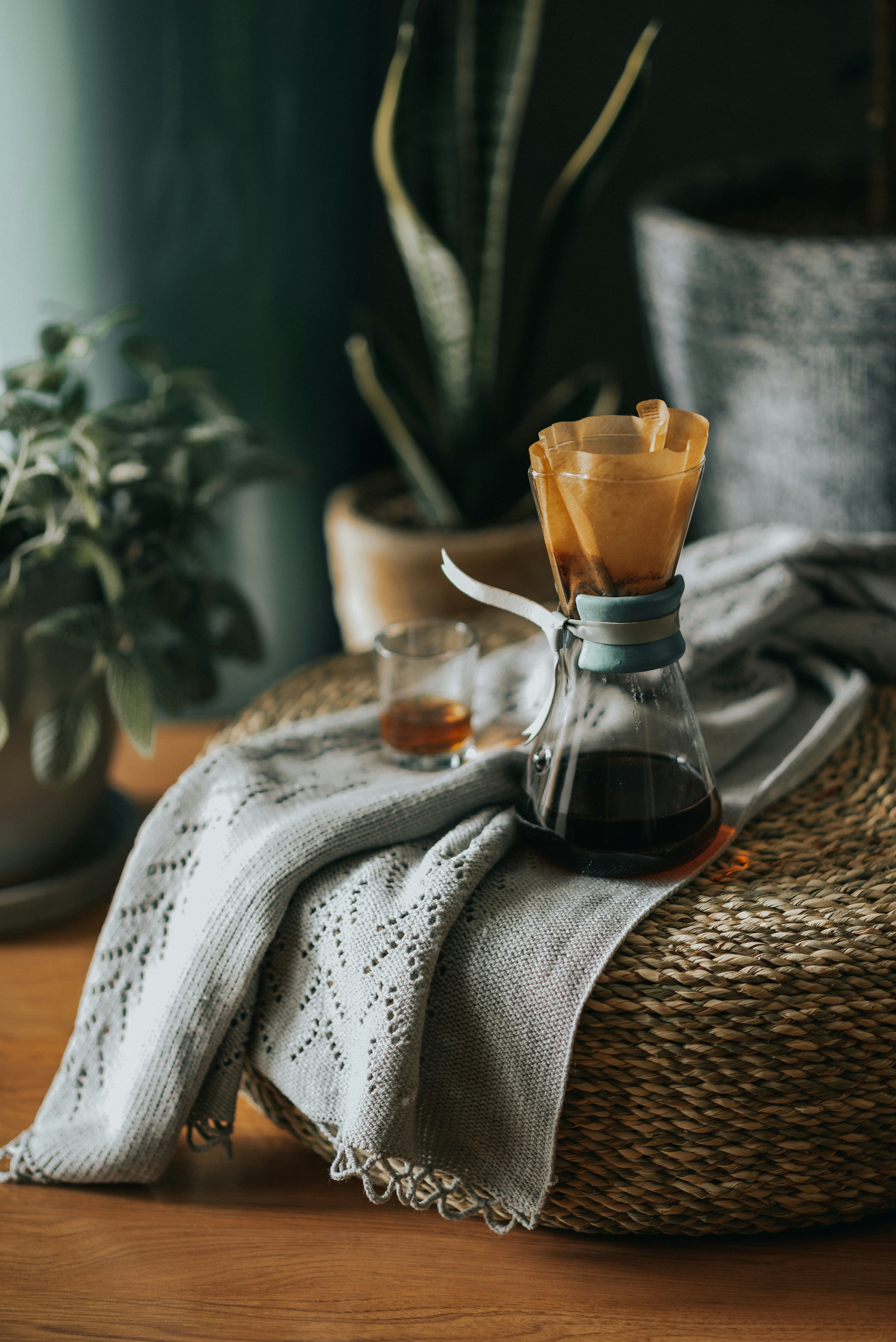How To Make Chemex Coffee
Imagine the rich, aromatic smell of freshly brewed coffee swirling around your kitchen as you gently pour it into your favourite mug. Now, picture this same experience leveling up with a Chemex coffee maker, a time-tested classic complement for your tastebuds! Elevated from just a caffeine fix to an art form, brewing with a Chemex coffee maker may seem intimidating at first, but don’t worry. You will soon be on your way to mastering the art and perfecting that brew you love. This article is designed to be your guiding beacon in this lovely journey! Just sit back, relax, and enjoy as we guide you step-by-step into hitting that right note with your Chemex coffee!
This image is property of images.unsplash.com.
Understanding the Chemex Coffee Maker
The Chemex coffee maker is a popular piece of equipment in the world of specialty coffee for its elegant design, simplicity of use, and the ability to produce a clean cup of coffee. It’s pretty amazing how this seemingly simplistic device has earned a place in the permanent collection of the Museum of Modern Art for its exquisite design.
History of the Chemex Coffee Maker
Invented by Dr. Peter Schlumbohm in 1941, the Chemex coffee maker reflects the inventor’s knowledge and application of Chemistry. Schlumbohm’s goal was to make everyday items more functional, attractive, and enjoyable to use. He undoubtedly succeeded with the Chemex.
Design and Construction
Regarded as an example of “beautiful simplicity”, the Chemex consists of an hourglass-shaped vessel made of heat-resistant, non-porous borosilicate glass. The top chamber serves as a filter-holder, while the bottom chamber strains the brewed coffee. It’s sealed with a wood collar and leather tie, which serve as an insulation point for handling when it gets hot.
Different sizes and models of Chemex Makers
The Chemex is available in different sizes like 3-cup, 6-cup, 8-cup, and 10-cup models. In the cup measurements, “1 cup” equals 5 oz. There are also some variations in design, including the classic series, handblown series, and the glass handle series.
Before You Begin: Gather Your Supplies
Just like any method of brewing coffee, brewing with the Chemex requires some essential items and tools.
The Essential Items
You’ll need a Chemex coffee maker, Chemex bonded filters, a kettle, coffee beans, and a grinder. A scale is also useful for measuring the coffee and water.
Additional Tools You May Need
A gooseneck kettle for controlled pouring, a timer, and a brush for cleaning could all prove useful when brewing with a Chemex.
Selecting the Right Coffee Beans
The selection of coffee beans is quite significant to the taste of your Chemex coffee. Light to medium roast beans are perfect. It’s best to get beans that have been freshly roasted.
Preparing Your Chemex Coffee Maker
A tidy preparation leads to a tastier cup of coffee.
Inspecting Your Chemex for Damage
Before getting started, always inspect your Chemex. Check for any cracks or chips for safety and to avoid leaks.
Cleaning Your Chemex
Ensure your Chemex is clean. Any residual coffee oils can adversely affect the flavor of your brew. Warm water and mild soap will do.
Placing the Filter Paper
The thicker part of the Chemex filter should cover the pouring spout, ensuring the filter is seated properly. Then, rinse the filter with hot water to get rid of any paper taste and preheat the Chemex.
Grinding Your Coffee Beans
The proper grinding of coffee beans is one of the core factors influencing the quality of the brew.
Why Grind Your Own Coffee Beans
Grinding your own beans just before brewing ensures the freshest flavor. Pre-ground coffee tends to lose flavor over time.
Choosing the Right Grind Size
For Chemex, a medium-coarse grind is ideal. It should resemble sea salt. This size allows for a balanced extraction and prevents the filter from getting blocked up.
Grinding Process
A burr grinder gives the most consistent grind size. After measuring your coffee, grind it, and place it in the rinsed filter.
This image is property of images.unsplash.com.
Heating the Water
The water temperature is another crucial parameter in brewing.
The Importance of Water Temperature
Water temperature is key for proper extraction. Too hot, and your coffee can over-extract; too cool, your coffee may under-extract.
Methods for Heating the Water
Use a kettle to heat the water. Electric kettles with temperature control are handy for this, but a stovetop kettle will work fine.
Testing Water Temperature
The ideal brewing temperature is 195-205 degrees Fahrenheit. If you don’t have a thermometer, let the boiled water cool for a minute to reach the lower end of the required temperature range.
Brewing Your Coffee
Brewing with a Chemex follows the pour-over method.
The Pour Over Method
Pour water over the coffee grounds in a circular motion, starting from the center moving outwards, and then back to the center. This way, all the coffee is exposed evenly to the water.
The Key to a Good Extraction
Pouring slowly is vital. It should take about 3 to 4 minutes to pour all of the water. This ensures a good extraction time where coffee flavors are optimally extracted.
Brew Time
The total brew time should be around 4 to 5 minutes. If it’s too short, consider a finer grind, and if it’s too long, a coarser grind.
This image is property of images.unsplash.com.
Fine-Tuning Your Brew
Once you’ve mastered the basics, you can explore variations to fine-tune your brew.
Adjusting the Water-to-Coffee Ratio
A general rule of thumb is a 1:15 coffee-to-water ratio. You can adjust this ratio to find the strength of coffee that suits your taste.
Altering the Brewing Method
You might try a pulse pour or continuous pour method to see which one you prefer.
Changing the Grind Size
You can also change the grind size slightly to affect the brew. But remember to keep it within the medium-coarse range.
Cleaning and Care After Use
Taking care of your Chemex will influence the taste of your coffee and the longevity of the device.
Removing Used Coffee Grounds
Discard the coffee grounds immediately after brewing. The Chemex filter makes this easy—you just have to pick it up and toss it out.
Cleaning the Chemex
Rinse the Chemex thoroughly with warm water and mild soap if necessary. Avoid using harsh detergents.
Proper Storage
Once dry, store your Chemex in a clean, dry place.
Learning from Common Mistakes
There might be a few missteps when you’re starting out, but don’t worry—that’s part of the process!
Over Extraction
If your coffee is extremely bitter, it might be over-extracted—try using a slightly coarser grind or cooler water.
Incorrect Water Temperature
Water that is too hot or too cold can result in under-extracted or over-extracted brew, respectively.
Incorrect Grind Size
If your brew time is too short or too long, your grind size might be the problem.
Filter Misplacement
Misplacing the filter paper can lead to weak coffee or spillage.
Advanced Chemex Brewing Techniques
And for those coffee connoisseurs who love to experiment!
Double Brewing
Double brewing—brewing coffee with coffee instead of water—is an intense way to get a very strong cup of Chemex coffee.
Cold Brew with a Chemex
You can also make cold brew coffee in your Chemex for an entirely different flavor profile.
Incorporating Other Coffee Brewing Methods
Feel free to blend techniques from other brewing methods with your Chemex to see what fantastic concoctions you can come up with.
So now you know all there is to know about the Chemex coffee maker—why it’s loved by so many, how to use it, experiment with it, and take care of it. Time to make the perfect cup of coffee, Chemex style!









